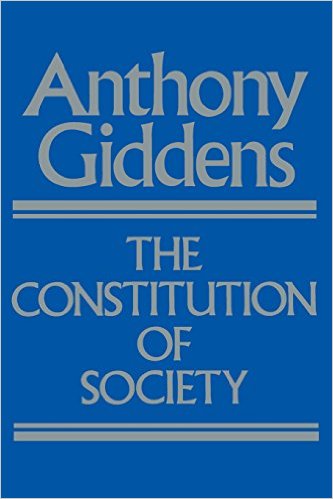
Every research investigation in the social sciences or history is involved in relating action to structure, in tracing, explicitly or otherwise, the conjunction or disjunctions of intended and unintended consequences of activity and how these affect the fate of individuals…. For the permutations of influences are endless, and there is no sense in which structure ‘determines’ action or vice versa. The nature of the constrains to which individuals are subject, the uses to which they put the capacities they have and the forms of knowledgability they display are all themselves manifestly historically variable. (p. 219)
Giddens makes an important point here, one frequently overlooked by scholars who emphasize either agency or structure in their work, and thereby failing to understand the two as heads and tails of the same situated, historical complex.
I think here of scholars intent on studying the meaning of a text, or aiming to determine lived experiences of a particular person, but who seem to overlook that meaning-making is not an individual activity and experiences are not the expression of a lone sentiment; rather, they each require prior conditions to be in place. To pick but one element, there’s no linguistic meaning without non-agential yet enabling (and thus constitutive) rules, like syntax. That is, no one actor made the rules (instead, groups of actors, generations and generations of users, who didn’t even know one another, did), and thus no matter how much agency we think individual actors may have there is a structure that exists apart from them all (like the structure WordPress provides for me as I type this post) that establishes the conditions in which — in this one example — the activity called meaning-making (when reading a blog, for instance) can take place.
And, inasmuch as they work within such a prior setting, people reconfirm it…, and, inevitably, tweak it just a bit — after all, there’s slips of the tongue, slang, and all sorts of unintended linguistic consequences that make meaning-making a dynamic, living thing.
So sure, you can focus your work on agency or just on structure, but, in doing so, you probably need to consider that both terms might just be handy shorthands for an inherently intertwined situation.
Case in point, consider a recent radio story on what social scientists call the stereotype threat.
 Give it a listen (or click here if the embedded player fails).
Give it a listen (or click here if the embedded player fails).
So here we have a case of agents who can be demonstrated to behave differently not when they’re treated differently (as in when someone interacts with them in a way that conveys the impression that they’ve been stereotyped by others) but when they’re simply reminded, by someone else, of the fact that they might be treated differently due to stereotypes — and what’s even more interesting is that their behavior can then conform to that very stereotype!
In this case, the actor is both agent and structure — something curiously reminiscent of a Freudian notion of superego or Althusser’s notion of interpellation is at work. For they act but also conform that action by means of self-monitoring (as we are likely often, maybe always, doing in typically reflexive manners).
Thinking back to Giddens, it therefore seems we’d be in error, then, or at least overly simplifying the situation, if we not only failed to see in this an example of how structures are the cumulative results of prior agents (e.g., the researchers who set up the above experiment), who are themselves creatively working within settings established by yet others — and so on, and so on — but also if we overlooked that this thing we call the individual, is simultaneously both the producer of those structures but also their product — demonstrating nicely that agency and structure are forever co-constitutive or, to put it another way, just words we coin to get at different moments of what is actually one coherent process.

